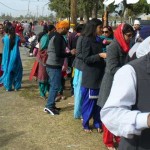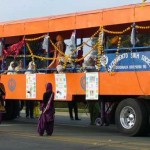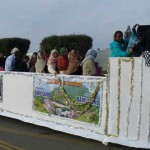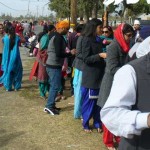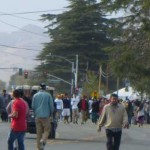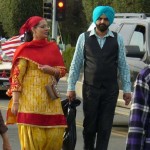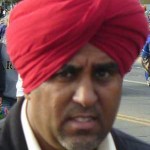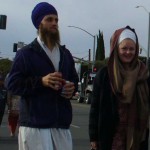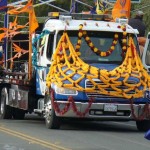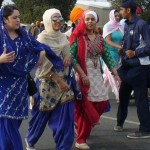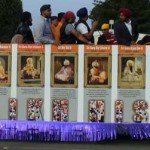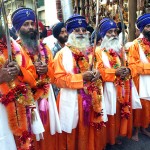Posted by Jack
The following is a wikipedia definition followed by a Sikh history, but first I wanted to interject what I found by attending the Sikh festival in Yuba City last weekend. Sikhs believe in one supreme God they call the One. They are taught to respect all religions and incorporate many beliefs from those other religions into Sikhism. They are a very inclusive faith and they embrace some of the the teachings of prophets of the Bible and in the Koran, although Islam has not shown the same respect in return, as you will find out if you read the history sh0wn below.
Sikhism is the 5th largest religion in the world with about 25 million members world-wide.
“At a typical gurdwara, the doors open up at 6 a.m. for prayers. A formal service includes the singing of hymns and a team of leaders who have studied the faith reciting from the Guru Granth Sahib, Sikhism’s holy scriptures. That book, more than 1,400 pages long, includes writings from Sikhism’s 10 gurus as well as writers from other religions.”
My best short form definition of Sikh’s is, they are a peaceful and warm people, but they are not passive when challenged by injustice. They believe they are obligated to defend their faith and defend the weak against injustice and oppression. You will find some of the best principles of the Bible, the Koran and Buddhism within the teachings of past and present Guruhs. For more on what Sikh’s believe please use this link. You might also like this link about Sikh’s in California. Click here.
I was very impressed with what I learned about Sikhs and I think you will be too. There’s been so much misunderstanding about who they are and what they believe that it often results in prejudice and ridicule, which is totally unjustified when compared with the facts.
(Excerpt) Sikh History – The Life and Times of Guru TegBahadur
Guru Teg Bahadur laid down his life in order to protect the rights of the common man – the right to live a life of dignity, the right to live a life without fear and the right to live a free life in their own lands. Guru Teg Bahadur’s legacy guides Sikhs to stand up against oppression. Before we get into details let’s revisit the social and political climate of India between the 15th and 17th centuries and the birth of Sikhism under Guru Nanak.
In the 15th century, the Indian society was deeply divided into Hindus and Muslims. Muslim invaders had occupied India by the 13th century and had started a forceful conversion of Hindus to Islam. On the other hand, Hindu society was plagued by rigid caste structures – so much so that women, the low castes and the poor were deprived of the basic human right to an honorable living.
In this society, Guru Nanak’s Sikhs or disciples created a whole new identity for themselves – a society in which men and women were treated equally and there were no class discrimination. Moreover, Guru Nanak’s teachings emphasized, nam japna or remembering God in one’s actions, kirt karni, or earning through honest and creative work, and wand chhakna- or sharing earnings with others – these teachings became the hallmark of the new Sikh society.
The other Gurus built the Sikh values on top of these ideals and at the same time never deviated from the teachings of Guru Nanak. When Guru Angad took over Guru Nanak’s mantle he collected Nanak’s teachings. He standardized Gurmukhi script and gave the Sikhs their own written language. Guru Angad’s emphasis on physical fitness for Sikhs laid the foundation for Guru HarGobind to later raise an army of able bodied men in a very short period of time.
Guru Amardas, as the third Sikh Guru, defined the Sikh ideals clearly and precisely for a whole range of important issues. He fought against the caste structures and against oppression of women. His most notable hymn the “Anand” is sung at all religious ceremonies of the Sikhs. Guru Amardas was also responsible for instituting the festival of Vaisakhi. and even today Sikhs from all walks of life and all parts of the world celebrate the festival together.
The fourth Guru, Guru Ramdas, was a true visionary for his ability to foresee the need for a moral and ethical code of conduct for Sikhs. At every Sikh wedding today, the profound spiritual hymns known as the “Laavan” which were composed by Guru Ramdas guide a couple to live their life as one soul and embody trust in each other.
Guru Arjan was the fifth Guru. He composed a number of hymns and compiled the teachings of the previous Gurus into the Adi Granth. Guru Arjan penned the hymn Sukhmani, constructed the Harmandar and established the city of Amritsar as the nerve center of the Sikhs. By the end of the 16th century, the Sikhs had become conscious of the fact that they were neither Hindus nor Muslims but formed a third community of their own. Times were rather peaceful, and the Sikhs thrived in Punjab and all over India.
However, in 1606 when Jehangir was crowned the Mughal emperor of India, he started persecuting the Sikhs. Jehangir had premeditated action against Guru Arjan, and within 7 months of him becoming the emperor, Jehangir had Guru Arjan executed.
This horrendous act changed the course of Sikh History and under the leadership of the young Guru HarGobind, the Sikh emphasis changed from a peaceful propagation of the teachings of the Sikh gurus to the forthright declaration of the right to defend their faith by arms. In 1609, Guru HarGobind built the Akal Takht and infused in the Sikhs a confidence that they could challenge the might of the Mughals and stand up against social persecution.
During Guru HarGobind’s Guruship, Shah Jahan, the Mughal emperor, extended his hostility towards the Sikhs, and his forces attacked the Sikhs 4 times. In all 4 battles, the rather small Sikh forces conclusively defeated the Mughal army. To avoid any hostilities with the Mughals and to concentrate on the welfare of the Sikhs, Guru HarGobind retired to Kiratpur, in the foothills of the Himalayas and a place not easily prone to attacks by the Mughals.
Teg Bahadur was the youngest son of Guru HarGobind. His birth name was Tyag Mal and he was born on April 1st, 1621. Tyag Mal spent his childhood in the company of Baba Buddha and Bhai Gurdas who taught him the arts of archery, horse riding as well as a thorough understanding of the hymns of all the earlier Gurus as recorded in the Adi Granth. In February 1633, he was married to Gujari, the daughter of Lal Chand and Bishan Kaur of Kartarpur.
In 1634, when the Mughal forces attacked Guru HarGobind in Kartarpur, Tyag Mal and his elder brother Gurditta had successfully defended the Sikhs. Guru HarGobind was so impressed with the provess of Tyag Mal, that he gave him the name Teg Bahadur – or one who is a master of the sword.
Soon after the battle of 1634 in Kartarpur, Guru HarGobind retired to Kiratpur, it the foothills of the Himalayas to concentrate on the welfare of the Sikhs. One drawback of retreating away from Amritsar to Kiratpur was that Guru Arjan’s rebel son, Prithi Chand’s successors, also known as the Minas occupied Amritsar. Prithi Chand’s son Meherban was close to the Mughal rulers, and he occupied the Harmandar Sahib which remained under him and his son Harji’s control from about 1635 to 1695. The Minas played havoc with the Sikh ideology and introduced a lot of mythology into the teachings of Guru Nanak and other Sikh gurus.
As a result, to counter the influence of the Minas, Guru HarGobind sent Teg Bahadur to Bakala, a town situated midway between the present day cities of Amritsar and Jalandhar. Teg Bahadur took immense interest in the activities of the Sikhs and after the death of Guru HarGobind in 1644, made Bakala his home. When Guru HarRai was appointed the 7th Sikh Guru, Teg Bahadur worked closely with him and would often come to visit him in Kiratpur. There are a lot of stories that say that Teg Bahadur was in meditation at Bakala. However, given the circumstances and the proximity of Bakala to Amritsar, it is quite likely that Teg Bahadur’s time in Bakala was spent in preserving the teachings of the Adi Granth, perhaps even making copies of it for distribution to Sikh centers all over India.
In 1656, Tegh Bahadur visited Guru Har Rai in Kiratpur – this time also coincided with a visit from the masands of far east who wished for Guru Har Rai to travel to the areas of Bihar and Bengal. Being preoccupied with the affairs at Kiratpur, Guru Har Rai deputed Tegh Bahadur to travel to the east. On June 9, 1656, Tegh Bahadur left Kiratpur and traveled as far as Bihar, Bengal and Assam and spent almost 8 years in the region.
In the meantime, on June 15, 1659, Aurangzeb, having killed all of his brothers who could have been possible claimants to the Mughal empire, declared himself as the Mughal emperor and established his capital in Delhi. Aurangzeb’s coming to power marked the beginning of a long, consistent and active policy of persecution of the Sikhs as well as the Hindus.
Aurangzeb first ordered a complete ban on the construction of new temples and in due course he further imposed a ban on the repairs of old temples as well. As the temples began to wear out, he finally ordered their demolition – this was in keeping with his goal of eventually converting everyone in India to Islam and making India a Dar-ul-Islam, or a Muslim only state. The persecution first started in Bihar, Bengal and Orissa, and slowly spread to all areas of India.
Ancient Hindu temples in Banaras and Mathura were also destroyed.
On 6th October 1661, Guru HarRai passed away and appointed his 5 year old son, HarKrishan as the eighth Sikh Guru. In 1664, Aurangzeb summoned Guru HarKrishan to Delhi. Although Guru Harkrishan came to Delhi, he repeatedly refused to meet with Aurangzeb, who ruled all of India from only a few miles away in Old Delhi.
Simultaneously, in March 1664, an epidemic of small pox broke out in Delhi. Due to its communicable nature not many people were inclined to help the suffering population. In this environment, Guru HarKrishan and his Sikhs stepped forward to help the needy and provide care for the suffering population. The well established practice of Daswand and langar or community kitchen ensured that there was always enough money and food to take care of the ailing and the needy. Unfortunately, while taking care of the smallpox patients, Guru HarKrishan himself was infected, which led to his untimely demise on March 30, 1664. He was only 7 years and eight months at the time.
Before passing away on March 30, 1664, Guru HarKrishan appointed Teg Bahadur as the ninth Sikh Guru. Teg Bahadur was also his grandfather Baba Gurditta’s younger brother – affectionately called as Baba Bakala, or the elder uncle who lived in Bakala. Also, Guru HarKrishan sensed that if Aurangzeb came to know that Teg Bahadur would succeed him as the next Guru, it could upset the delicate peace between the Sikhs and Aurangzeb.
For the next few months Guru Teg Bahadur retreated to Bakala and kept a low profile. This prompted some speculation as to the identity of the new Guru. Sensing an opportunity, Dhirmal, the grandson of Guru HarGobind, declared himself as the ninth Sikh Guru, and set up his camp at Bakala.
On October 9, 1664, Makhan Shah Lubana, a prominent Sikh merchant from Gujarat, visited Bakala. He was responsible for collecting the Dasvand, or voluntary contribution from the Sikhs in Gujarat and bringing it over to the Gurus every year. When he reached Bakala, he was surprised to find DhirMal was propped up as a Guru. However he was able to confirm the Guruship of Guru TegBahadur and steered the Sikhs away from the imposters.
It should be noted that Makhan Shah and his family was intimately connected to the Gurus. Earlier when Guru HarRai had toured Kashmir in 1661, he had stayed with Makhan Shah’s father Bhai Dasa, in his ancestral home at Wazirabad, now in Pakistan. There are many stories surrounding these events, however these stories were invented much later in order to insert mythical aspects to the actual events.
In November 1664, Guru Teg Bahadur embarked on a tour of the Punjab, and reached Amritsar. Harmandar Sahib, founded earlier by Guru Arjan was by now under the control of the Minas led by Harji, the grandson of Prithi Chand. They did not allow Guru Teg Bahadur to enter the Harmandir sahib and shut all the 4 entrances. Guru Tegh Bahadur did not force his way but calmly continued on his tour through the Majha and Malwa regions of Punjab and spent some time in Kiratpur.
In May 1665, Guru Teg Bahadur purchased a piece of land near the Makhowaal region of Punjab from the estate of Raja Deep Chand, who had recently passed away. This town was renamed as Chak Nanaki after his mother. In due course of time, the beautiful town of present day Anandpur grew up around it.
Guru Teg Bahadur’s stay at Anandpur was short and in August 1665 he set out on travels to eastern India. These travels were specifically tailored with the aim of instilling confidence amongst the people – mainly Hindus who feared retribution by Aurangzeb. This did not go well with the local Muslim clerics and on their complaints Aurangzeb arrested Guru Teg Bahadur. Favorably for the Sikhs, Raja Ram Singh, son of Raja Jai Singh who had hosted Guru HarKrishan in Delhi a few years ago, interceded and the Guru was released.
Guru Teg Bahadur continued his journey – this time traveling eastward to Mathura, Banaras and eventually to Patna. He left his family at Patna and continued further to Bengal and Assam. Almost 150 years ago, Guru Nanak had visited these areas and there was a sizeable Sikh population that flourished in both Assam and Bengal. In December 1666, Guru Teg Bahadur’s only son Gobind Rai was born in Patna. With Patna as a base, Guru Teg Bahadur continued to travel peacefully throughout the region till about 1670.
Meanwhile, Aurangzeb had grown more intolerant of the Hindus and on April 8, 1669, he issued orders to the governors of all his provinces to destroy, without any mercy, all schools and temples of the Hindus and in particular they were strictly instructed to put an end to the practice of idol worship. Under these circumstances, Guru Teg Bahadur decided to return to the Punjab.
Back in Punjab, Guru Teg Bahadur traveled extensively and moved about with the people of Punjab, constantly uplifting their spirits against all the atrocities of Aurangzeb. The principle of justice, as laid out earlier by Guru Nanak, formed an important feature of his ideology. He emphasized that the exploitation of poor by the rich was unjust and equally unjust was for the poor and weak to compromise with such oppression and tyranny.
Guru Teg Bahadur said that living a truly spiritual life meant that one should neither oppress nor allow to be oppressed. Ever since Guru Nanak, Sikh teachings have emphasized the basic human rights of equality, justice, freedom and religion. Under the inspiring teachings of Guru Teg Bahadur, the Sikhs regained their confidence and continued to grow in numbers and resources.
This tour lasted about 4 years and in 1674, he came back to Anandpur. Even while traveling, Guru Teg Bahadur was deeply connected with the teachings of the Sikh Gurus and he himself composed about 116 hymns that were added to the Adi Granth by Guru Gobind Singh. He showed a remarkable understanding of music and his compositions are spread over 15 Ragas. He also introduced the Raga JaiJaiwanti for his compositions.
Meanwhile, Aurangzeb had accelerated his efforts to convert all Hindus to Islam. At that time in Hinduism, the Brahmins of Kashmir and Banaras enjoyed a reputation of being the wisest and most knowledgeable amongst all Hindu priests. Hence, Aurangzeb decided to convert them first in the hope that once the wisest of them had embraced Islam, the rest would have no choice but to follow suit.
Iftiyar Khan, the Governor of Kashmir, redoubled his efforts to persecute the Brahmins of Kashmir . The Brahmins approached the Rajput kings for protection. These kings, not wanting to upset their equation with Aurangzeb, did nothing to protect the Hindu Brahmins. As a last resort, they decided to approach Guru Teg Bahadur for guidance via one of his disciples, Kripa Ram.
It has been said in various stories that Kripa Ram was a Kashmiri Brahmin. This is another story that needs attention. When Guru Nanak had visited Kashmir about a 150 years earlier, he had debated the Sikh philosophy with a learned Brahmin, Pandit Bhram Das. Bhram Das was so impressed with Guru Nanak’s philosophy that he became a follower and dedicated his life to spread Guru Nanak’s message.
Subsequently, his son Narain Das was intimately connected with Guru HarGobind and his grandson Aru Ram with Guru HarRai. Kripa Ram was Aru Ram’s son, and hence belonged to family that had served the Sikh gurus for 4 generations.
The Kashmiri Brahmins appealed to Kripa Ram to arrange for a meeting with Guru Teg Bahadur in Anandpur. This meeting took place on May 25, 1675 and Guru Teg Bahadur provided them with moral encouragement. He also told the Brahmins to go back and tell the authorities that they would embrace Islam if they could prevail upon Guru Teg Bahadur to embrace Islam. This only served to precipitate the differences between the Sikhs and the Mughals.
During this time, Aurangzeb was busy in Hasan Abdal, now in Pakistan, quelling a rebellion by the Pathans. He was already circumspect of the Sikhs and deputed his governors to keep a watch on the affairs of the Sikhs. These governors, sent highly misleading reports to Aurangzeb, sometimes even saying that Guru Teg Bahadur was persecuting Hindus by collecting taxes. Inclined to believe his governors, Aurangzeb wrote to the Governor of Lahore, Muzzafar Hussain, to arrest Guru Teg Bahadur. Muzzafar passed on the order to Dilawar Khan, the commander of Sirhind, who in turn passed it to Nur Mohammad Khan, an official in Ropar.
Guru Teg Bahadur, sensing trouble, proceeded towards Delhi on July 8, 1675. He hoped to meet with Aurangzeb and resolve the crisis. He was well aware that in case the talks did not succeed, he himself would have to face the consequences. On July 12, 1675, on his way to Delhi, Guru Teg Bahadur, along with his followers Mati Das, Sati Das, Dayala and numerous others were arrested near Ropar and sent to Sirhind. They were kept here until Aurangzeb returned to Delhi from Hasan Abdal. In Delhi, they were imprisoned in Chandni Chowk, just outside of Aurangzeb’s capital at the Red Fort.
Aurangzeb, was inflexible in his religious views and was under the influence of the Naqshbandi order. This was the same Naqshbandi order that under Sheikh Ahmad Sirhindi, had turned Jehangir against Guru Arjan. Now Sirhindi’s grandson Saif-ud-din was Aurangzeb’s spiritual guide. Earlier, Aurangzeb had also justified the murders of his brothers and the imprisonment of his father Shah Jahan on the ground of his devotion to the cause of Islam. In this frame of mind, Aurangzeb offered two alternatives to Guru Teg Bahadur: 1. To Embrace Islam or 2. To prepare himself for a torturous death.
Guru Teg bahadur refused to convert to Islam and upheld his right to freedom of religion, not only for the Sikhs but also for all other religious sects in India, including the Hindus, the Jains, the Buddhists etc. To terrify the Guru, his followers, Bhai Mati Das, Bhai Sati Das and Bhai Dyala were inhumanly tortured to death by pouring boiling water on them and by sawing them alive. On November 11, 1675, Guru Teg Bahadur was beheaded in a public execution.
The Gurdwara Sis Ganj now stands in Chandni Chowk in Delhi, at the place where Guru Teg Bahadur was beheaded. His body was collected by one devout disciple, Lakhi Shah Vanjara. To avoid any suspicion by Aurangzeb, he cremated Guru Teg Bahadur’s body in his own house and took his head to Anandpur. At the site of Lakhi Shah’s house, the Gurdwara Rakab Ganj now stands next to the Indian Parliament. The place where Guru Teg Bahadur’s head was cremated in Anandpur is also known as Sis Ganj.” End


